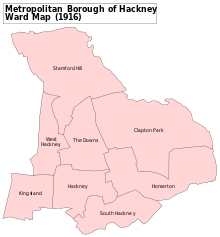Lower Clapton
| Lower Clapton | |
 Lower Clapton's unusual Round Chapel. Built in 1869–71 as a Congregational church, it is now an arts centre. It is considered to be one of the finest non-conformist buildings in London. |
|
 Lower Clapton |
|
| OS grid reference | TQ355855 |
|---|---|
| – Charing Cross | 5 mi (8.0 km) SW |
| London borough | Hackney |
| Ceremonial county | Greater London |
| Region | London |
| Country | England |
| Sovereign state | United Kingdom |
| Post town | LONDON |
| Postcode district | E5 |
| Dialling code | 020 |
| Police | Metropolitan |
| Fire | London |
| Ambulance | London |
| EU Parliament | London |
| UK Parliament | Hackney South and Shoreditch |
| London Assembly | North East |
Coordinates: 51°33′08″N 0°02′49″W / 51.55212°N 0.04704°W
Lower Clapton /ˈklæptən/ is a district of East London[1] in the London Borough of Hackney.

It is immediately adjacent to central Hackney – bounded, roughly, by:
° West: The Rectory Road to Hackney Downs rail line (though both stations are just outside Clapton), taking in Hackney Downs park.
° East: The Lea Valley
° South: Clifden Road
° North: Lea Bridge Road\Kenninghall Road. Upper Clapton lies north of these roads.
Lower Clapton is centred on Lower Clapton Road, to the north of which is Clapton Pond, the remnant of the old village green.
Clapton Pond and the late Georgian Clapton Square are the area's two major conservation zones.
Hackney Downs, one of the larger open spaces in Hackney, is formally within this district, though many people consider the Downs to be an area of Hackney in its own right.
Like many other parts of East London, Lower Clapton is socially diverse and multicultural. Chatsworth Road, which had a regular market until the 1990s, still provides many amenities for people who live in the area. A new Sunday market has been established here since December 2010. The shops and restaurants on Chatsworth Road reflect the diversity of the surrounding streets – offering African, Turkish, Asian and Caribbean produce alongside butchers, bakers and greengrocers. More recent additions include a creperie, coffee shops and a French delicatessen, part of the area's vaunted gentrification in the lead up to the 2012 Olympic Games.
Lower Clapton has a relatively large amount of green space for a district of inner London. In addition to Hackney Downs, the area is bordered by Millfields Park, Clapton Park, and Hackney Marshes.

Large parts of Lower Clapton look much as they did when the area was first developed in the second half of the 19th century. Most of the housing stock consists of Victorian terraces of various sizes. Several highrise LPS constructions erected by the Council in the late 1960s and early 1970s were demolished in the 1990s to make way for lowrise Local Authority housing, e.g. the Clapton Park Estate.
Notable residents have included John Howard, Nathaniel Woodard who was a curate of St. John's, Harold Pinter, Helen Shapiro and Jessica Tandy. Clapton F.C. was the original local football team, being formed in 1878.
A number of shootings that took place in the 1990s and early 2000s on Upper and Lower Clapton Road earned the locality the nickname "Murder Mile".[2] During the 2011 England riots, Clarence Road, near the epicentre of the rioting, was the site of Pauline Pearce's Heroine of Hackney speech.[3]
Education
Secondary schools in the area include Clapton Girls' Academy and Mossbourne Community Academy. Mossbourne is located on the site of the former Hackney Downs School. Millfields Community School is regularly said to be one of the most improved schools in the country and was visited by Tony Blair in 2005 [4]
Transport
- Nearest railway stations
 |
Upper Clapton | Lea Bridge |  | |
| Hackney Downs | |
Hackney Marshes | ||
| ||||
| | ||||
| Hackney Central | Homerton |
References
- ↑ "London Places" (PDF). Greater London Authority. GLA. Retrieved 11 October 2015.
- ↑ Thompson, Tony (2001-04-22). "Two more die on 'murder mile'". The Guardian. Retrieved 2011-05-17.
- ↑ "Hackney 2011: the year that was". Hackney Citizen. 7 January 2012. Retrieved 17 January 2012.
The Pembury Estate in Central Hackney was the epicentre of the pillaging and burning that raged down Clarence Road, Narroway and Mare Street [...]
- ↑ Kenny, Ursula. "Ursula Kenny on how Anna Hassan turned around Millfields primary school in Hackney". the Guardian. Retrieved 2015-09-02.
External links
- The Round Chapel Auditorium
- Clapton from British History Online
- Clapton Pond Neighbourhood Action Group
